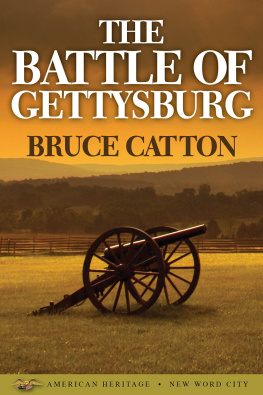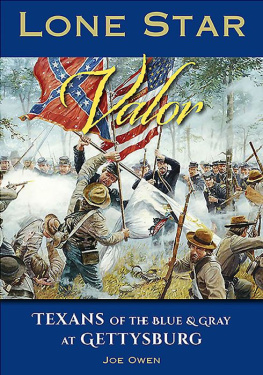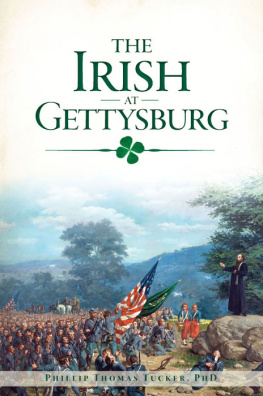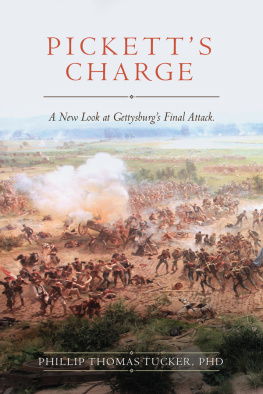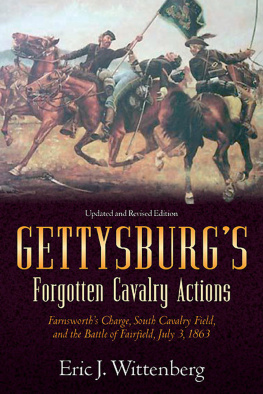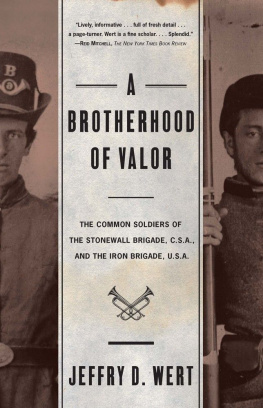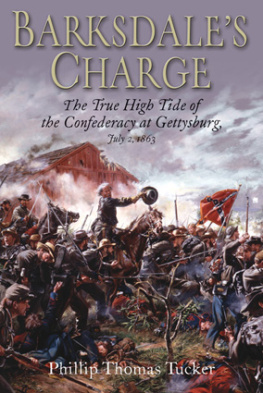I thank all the following individuals and organizations for giving permission to publish the following items. Ayer Company for Soldier of the South: General Picketts War Letters to His Wife; Regional/Genealogical Publishing Company for quotations from Maud Carter Clement, The History of Pittsylvania County Virginia; Pennsylvania Historical and Museum Commission for Frank Haskells Gettysburg; Special Collections Library, Duke University for A. N. Jones to W. Fry, July 5, 1863, Joseph Mayo to Charles Pickett, July 25, 1863, and W. W. Bentley to W. T. Fry, July 9, 1863, in the George Edward Pickett Papers; Colgate University Library and Edmonston Publishing, Inc. for quotations from Thomas Ward Osborn, The Eleventh Corps Artillery at Gettysburg. The Papers of Major Thomas Ward Osborn; New Hampshire Historical Society for Tully McCrea to John Bachelder, 30 March 1904 and Anthony McDermott to John Bachelder, no date, Bachelder Papers; Vermont Historical Society for Wheelock Veazey to G. G. Benedict, 11 July 1864; Mississippi State Archives for William Peels Diary; Frank Yates of Richmond for Henry T. Owen to Col. H. A. Carrington, January 27, 1878; Mr. William Walker of Mandeville, Louisiana for David Johnstons untitled essay; Museum of the Confederacy for Report of Col. R. M. Mayo, August 14, 1863; Gettysburg National Military Park for Augustin Parsons to ?, June 2, 1889, excerpts from the Diary of Walter A. Van Rensselaer, Gulian Weir, Recollections of the 3d day at Gettysburg with Battery C, and J. L. Kemper to W. H. Swallow, February 4, 1886; Minnesota Historical Society for Daniel Bond, Bond Recollections; University of Virginia for Erasmus Williams to John Daniels, no date, John Daniels Papers; North Carolina State Archives for Louis S. Young to William J. Baker, February 10, 1864, Francis Winston Papers; Virginia Historical Society for James Hodges Walkers essay; Maryland Historical Society for Isaac Trimbles diary in Maryland Historical Magazine.
In a sense, this book is a product of the Civil War Round Table of Long Beach, of which I have been a member for several years, and President for the last five years. It is a friendly, interesting and helpful group, and many of them have contributed to this effort in various ways. Since I might forget someone if I started naming individuals, Ill just say thanks to each and every member.
Steve Madden, George Otott, and Jim Stanbery read each and every word of this book in various drafts, and discussed it with me at length. Their comments ranged from conceptualization to specific details, and helped me clarify issues and avoid stupid mistakes. Harold Bernstein and Ed Franks read and criticized the introduction, and their comments were also very helpful. Every writer and editor needs readers who can criticize, stimulate, and suggest improvements. I cant thank them enough. If this book is a success in any way, it is partially due to their efforts.
Scott Hartwig at the Gettysburg National Military Park Library helped me locate several documents. Some of the research Wayne Motts did for me on the capture of Confederate flags at Gettysburg was useful in this book.
Roy Marcot and Lee Merideth, both of whom have published outstanding books of their own, gave me great guidance in the technical and business aspects of publishing.
Cliff, Peggy, Junie and Ermine Bream opened their homes to me and gave me a wonderful, unforgettable week in Gettysburg and Leesburg. Junies fresh-water pool provided a spectacular means of cooling off after long days on the battlefield, walking Picketts Charge from several perspectives. Cliff opened my eyes to see what the Charge looked like from the perspective of Kempers brigade, and gave me a whole new, and historically more comprehensive, understanding of what happened there.
Much of this book is in part a result of hours of conversation with Dave Shultz. He knows more about Federal artillery on July 3rd than I ever will, and he has taught me much about it. Some day he will publish a superb book on that subject. He worked long and hard drawing the maps included here, and his talents both as an historian and artist enhance this book.
All of the mistakes and errors are my own.
The following maps seek to portray, as accurately as possible, the positions of all Federal and Confederate units near the Angle at the crest of the charge and to portray the positions, as accurately as possible, of the individuals in the book and a few selected additional men. All positions are based on primary documents. The Federal units are placed at their location at the height of the charge; the Confederates are portrayed as coming up the slope just before the crest. Virtually all accounts agree that the Confederates were in a mass, not in perfect lines of battle, after they crossed Emmitsburg Road, and thus their lines are drawn with dotted lines to indicate flexibility. The Federal troops of Harrows and Halls brigades arrived at the copse of trees out of formation, so they too are represented by broken lines. All positions are as accurate as information allows them to be, and are subject to revision. Finally, since the timing of the assault is somewhat in question, all times are approximate, and are calculated with the assumption that the charge began at 3:00 P.M.
MAP 1: ARTILLERY DURING THE CANNONADE
Federal
1st New York, Battery C. Capt. Almont Barnes. Four 3 Ordnance rifles.
3rd Massachusetts Light, Battery C. Wolcott. Six 12 pdr. Napoleons.
5th United States, Battery D. Lt. Benjamin Rittenhouse. Six 10 pdr. Parrotts.
1st Ohio Battery L. Gibbs. Six 12 pdr. Napoleons.
1st New York Battery G. Capt. Nelson Ames. Left of McGilverys line. Four 12 pdr. Napoleons.
6th Maine Light. Lt. Edwin Dow. Six 12 pdr. Napoleons.
2nd Connecticut Light. Capt. John Sterling. Four James rifles, Two 12 pdr Howitzers.
1st Pennsylvania Battery H. Capt. Wm. Rank. Two 3 rifles.
15th New York. Capt. Patrick Hart. Four 12 pdr. Napoleons.
5th Massachusetts (10th New York attached). Captain Charles Phillips. Six 3 rifles.
Pennsylvania Artillery, Batteries C and F. Thompson. Five 3 rifles.
4th U. S. Battery C. Lt. Evan Thomas. Six 12 pdr. Napoleons.
9th Michigan. Capt. Jabez Daniels. Six 3 rifles.
1st New York Battery B. Capt. James Rorty. Four 10 pdr. Parrotts.
1st Rhode Island Battery B. Perrin. Six 12 pdr. Napoleons.
4th U. S. Battery A. Lt. Alonzo Cushing. Six 3 rifles.
1st Rhode Island Battery A. Capt. William Arnold. Six 3 rifles.
3rd U. S. Batteries F and K. Lt. John Turnbull. Two 12 pdr. Napoleons.
9th Massachusetts Light. Lt. Richard Milton. Two 12 pdr. Napoleons.
1st U. S. Battery I. Lt. George Woodruff. Six 12 pdr. Napoleons.
1st Ohio Light Battery H. Lt. George Norton. Six 3 rifles.
1st New Hampshire Battery Capt. Frederick Edgell. Six 3 rifles.
1st West Virginia Battery C. Capt. Wallace Hill. Four 10 pdr. Parrotts.
1st U. S. Battery H. Capt. Eakin. Six 12 pdr. Napoleons.
4th U. S. Battery G. Lt. Eugene Bancroft. Six 12 pdr. Napoleons.
5th New York Battery. Capt. Elijah Taft. Five 20 pdr Parrotts.
1st Ohio Battery 1. Capt. Hubert Dilger. Six 12 pdr Napoleons.
4th U. S. Battery B. Lt. James Stewart. Two 10 pdr Napoleons.
1st New York Battery 1. Capt. Michael Weidrich. Six 3 rifles.
1st Pennsylvania Batteries F and G. Capt. Bruce Ricketts. Six 3 rifles.
1st New York Battery L. Breck. Five 3 rifles.
5th Maine Light Battery E. Whittier. Six 12 pdr Napoleons.
4th U. S. Battery F. Lt. Sylvanus Rugg. Six 12 pdr. Napoleons.
5th U. S. Battery K. Lt. David Kinzie. Four 12 pdr Napoleons.
1st New York Battery M. Winegar. Four 10 pdr Parrotts (only two engaged.)


